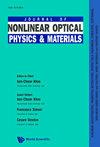A strategy for 2D MXenes as thermal management materials by laser shock nanoshaping
IF 2.3
4区 物理与天体物理
Q2 OPTICS
引用次数: 0
Abstract
The two-dimensional (2D) titanium carbides ( Tin+1Cn ) belong to the MXene family, with carbon and titanium alternating in a flake structure, and are emerging options for nanoelectronics applications. In this study, the feasibility of nanoshaping of 2D titanium carbides for tunable thermal management materials was investigated. 2D titanium carbides demonstrate high degrees of formability on nanoscale and efficiency as thermal management systems in nanoelectronics components. The thermal conductivity of various MXene 2D flakes was studied using molecular dynamics simulations. A robust thermal management behavior has been predicted for 2D MXenes after nanoshaping on various nanomold patterns, which will facilitate the development of MXene-based metamaterials for thermal management in electric nanocomponents. The size dependence analysis shows that the MXenes thermal conductivity is highly influenced by the flake size leading to a variation in experimental values due to scale factors. Our model showed that Ti2C is more sensible to strain at both supported and suspended conditions, while the thicker MXenes are not too influenced by strain. When supported, the thermal conductivities of all simulated MXenes considerably decrease due to Z phonon modes suppression. Bending strain also showed an effect in the MXenes thermal conductivity by scattering phonon modes. This makes MXenes an attractive option for the management of thermal fields.二维MXenes作为热管理材料的激光冲击纳米成形策略
二维(2D)碳化钛(Tin+1Cn)属于MXene家族,碳和钛在片状结构中交替存在,是纳米电子学应用的新兴选择。在本研究中,研究了纳米化二维碳化钛作为可调热管理材料的可行性。二维碳化钛在纳米尺度上表现出高度的可成形性和作为纳米电子元件热管理系统的效率。采用分子动力学模拟方法研究了不同MXene二维薄片的导热性。预测了二维MXenes在不同纳米模具模式下进行纳米成型后的强大热管理行为,这将促进基于MXenes的电子纳米元件热管理超材料的发展。粒径依赖性分析表明,MXenes的导热系数受粒径影响较大,导致实验值因粒径因素而发生变化。我们的模型表明,在支撑和悬浮条件下,Ti2C对应变更敏感,而较厚的MXenes受应变的影响不太大。在支持下,由于Z声子模式的抑制,所有模拟MXenes的热导率都大大降低。弯曲应变通过散射声子模式对MXenes的导热性能也有影响。这使得MXenes成为热场管理的一个有吸引力的选择。
本文章由计算机程序翻译,如有差异,请以英文原文为准。
求助全文
约1分钟内获得全文
求助全文
来源期刊
CiteScore
3.00
自引率
48.10%
发文量
53
审稿时长
3 months
期刊介绍:
This journal is devoted to the rapidly advancing research and development in the field of nonlinear interactions of light with matter. Topics of interest include, but are not limited to, nonlinear optical materials, metamaterials and plasmonics, nano-photonic structures, stimulated scatterings, harmonic generations, wave mixing, real time holography, guided waves and solitons, bistabilities, instabilities and nonlinear dynamics, and their applications in laser and coherent lightwave amplification, guiding, switching, modulation, communication and information processing. Original papers, comprehensive reviews and rapid communications reporting original theories and observations are sought for in these and related areas. This journal will also publish proceedings of important international meetings and workshops. It is intended for graduate students, scientists and researchers in academic, industrial and government research institutions.

 求助内容:
求助内容: 应助结果提醒方式:
应助结果提醒方式:


